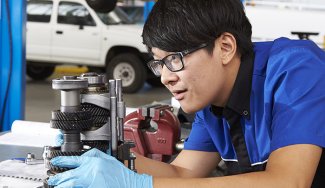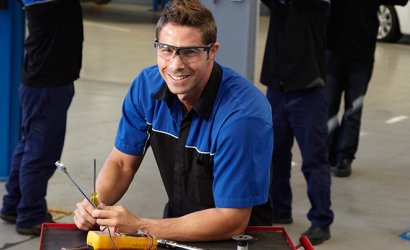

Why choose this course?
Fine tune your career in the automotive, service and repair industry by completing this qualification. This course covers the skills required to perform advanced diagnostic repairs on light vehicles.
You will gain the skills and knowledge to diagnose complex faults in petrol engines, electronic spark ignition engine management systems, braking systems and test engines.
During this course you will analyse and service power supplies in hybrid and electric vehicles, repair transmissions and drive assemblies, manage environmental compliance and comply with workplace safety and health legislation.
It is important to note that international students are not eligible for an automotive trade certificate due to visa restrictions. For more information, please visit tradesrecognitionaustralia.gov.au.
You can continue your studies by enrolling into the AUR50216 Diploma of Automotive Technology.
Career opportunities
- Automotive Master Technician
- Service Technician
When choosing a course, it's important to think about the key skills and knowledge you'll need, as well as how you'll be assessed. Take a look at this information and consider if you might face any challenges in meeting the course expectations and requirements.
- Good background in reading, writing and mathematics
- Ability to work well with manual hand tools and technical aptitude
- Practical with good problem-solving skills
- Good eyesight, vision for detail and hearing
- Communication and customer service skills
- Mechanical mindset and keen interest in automotive systems
-
An IELTS score (academic) of 6.0 with no band score less than 5.0 or equivalent.
-
Completion of AUR30620 Certificate III in Light Vehicle Mechanical Technology (or equivalent) is required for entry into this course.
There may be further semester intakes available for enrolment. You can view any further intakes when you submit your online application(opens in a new tab).
For information about pathways from TAFE to university, view our Pathways to university page.
How to apply
Apply to study at TAFE in six steps:
- find a course;
- check entry requirements;
- submit an application;
- accept your offer and pay;
- apply for your student visa; and
- receive your visa and come to Australia for your studies.
Build your own course guide
Select the study areas, courses and topics you like. Get your custom guide by email!
Download study area guide(opens in a new tab)
Contact us(opens in a new tab)
TAFE International Western Australia (TIWA) is the Registered Training Organisation (RTO) and Commonwealth Register of Institutions and Courses for Overseas Students (CRICOS) provider, for the delivery of training to international students, enrolled in a TAFE course in Western Australia. This nationally recognised course is delivered by a Western Australian TAFE college on TIWA's behalf. TIWA retains responsibility for the quality of the training and assessment delivered by the TAFE colleges and for the issue of certification documentation to students.


